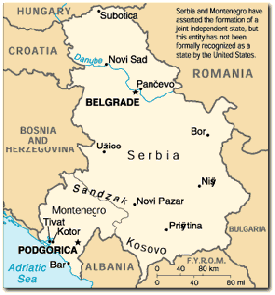Kosovo Factsheet

Kosovo is now a country! Read all about the Republic of Kosovo.
by Elissa Haney6 |
This article was posted on June 16, 1999.
 Related Links |
Where is Kosovo?
Kosovo is a southern province of the Federal Republic of Yugoslavia, which is composed of Serbia and Montenegro1. The country is about the size of Kentucky. It is bordered by Bosnia and Herzegovina, Croatia, Hungary, Romania, Bulgaria, Macedonia, and Albania.
The Factions
At odds are the Serbs, under the leadership of archnationalist Slobodan Milosevic, and the ethnic Albanians, who make up 90% of Kosovo's population. While Serbia is internationally recognized as having control over Kosovo, the Kosovo Liberation Army (KLA), a militant ethnic Albanian group, is calling for full independence for the province.
The ethnic Albanians of Kosovo share the ethnic background of the people of neighboring Albania and speak the Albanian language. They are largely Muslim, while the Serbians are generally Eastern Orthodox Christians.
At Issue
Kosovo was autonomous within the former Yugoslavia from 1974 until 1989, when new Serbian president Milosevic took control of the province. During their period of autonomy, the ethnic Albanians enjoyed a measure of cultural freedom that ended with Kosovo's absorption into the Serbian state.The Serbs are struggling to maintain control over Kosovo for cultural reasons as well. The territory has a significant role in Serbian history, as the site of the Serbs' defeat by the Ottoman Turks in 1389. The battle at Kosovo Field figures prominently in Serbian poetry and has great national significance as the cradle of Serbian civilization.
Setting the Stage
While the issues at the center of the fighting in Kosovo date back nearly two decades, the recent tension began to heat up after the emergence of the KLA in 1996. In 1997 the KLA took a more active role against continued oppression by the Serbs. They began killing Serbs in Kosovo, their main target being policemen. Eventually the KLA was able to establish control over areas within the province.In February 1998, President Milosevic sent Serbian troops to take back KLA-controlled areas. Eighty people were killed in the ensuing battle, including many women and children. The government-sponsored violence against Albanian civilians sparked rioting by outraged Kosovars and marked an escalation of the conflict.
It also gave cause for intervention by NATO, which, until that point, had never stepped into the middle of a conflict between a sovereign nation and its own citizens. In justifying its involvement, NATO cited the responsibility of protecting fellow human beings from crimes against humanity.
After months of unsuccessful attempts at restoring peace to Kosovo, NATO resorted to military action in the spring of 1999. On March 24 it launched an air campaign that would last for 78 days.
As bombs fell on Serbian soil, Western officials debated the likelihood of defeating the Serbs without the deployment of ground troops. NATO's hesitation in committing to a land battle —and therefore putting its troops at greater risk of danger— ultimately paid off. Serbia finally agreed to sign a UN-approved peace agreement with NATO on June 9.
1. The United States does not recognize the new government as the successor state of the former Yugoslavia, and refers to it as "Serbia and Montenegro."







